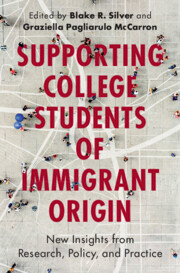Book contents
- Supporting College Students of Immigrant Origin
- Supporting College Students of Immigrant Origin
- Copyright page
- Dedication
- Contents
- Figures
- Tables
- Contributors
- Foreword
- Part I Beginnings
- Part II Experiences
- Chapter 6 Funds of Knowledge as Strategic Food and Campus Navigation at Selective, Affluent Universities
- Chapter 7 Psychosocial Stressors and Coping Strategies in Racially and Ethnically Diverse Undocumented College Students
- Chapter 8 How Colleges Can Support Working Students of Immigrant Origin
- Chapter 9 First-generation College Student Women of Immigrant Origin and Perspectives on the Role of Gender in their Experiences On- and Off-campus
- Chapter 10 Second-generation Afghan Immigrants Navigating Racial and Ethnic Identities in College
- Chapter 11 The COVID-19 Pandemic and Undocumented Hispanic/Latino/x College Men
- Part III Institutional Arrangements
- Part IV Looking Forward
- Epilogue
- Index
- References
Chapter 10 - Second-generation Afghan Immigrants Navigating Racial and Ethnic Identities in College
from Part II - Experiences
Published online by Cambridge University Press: 16 May 2024
- Supporting College Students of Immigrant Origin
- Supporting College Students of Immigrant Origin
- Copyright page
- Dedication
- Contents
- Figures
- Tables
- Contributors
- Foreword
- Part I Beginnings
- Part II Experiences
- Chapter 6 Funds of Knowledge as Strategic Food and Campus Navigation at Selective, Affluent Universities
- Chapter 7 Psychosocial Stressors and Coping Strategies in Racially and Ethnically Diverse Undocumented College Students
- Chapter 8 How Colleges Can Support Working Students of Immigrant Origin
- Chapter 9 First-generation College Student Women of Immigrant Origin and Perspectives on the Role of Gender in their Experiences On- and Off-campus
- Chapter 10 Second-generation Afghan Immigrants Navigating Racial and Ethnic Identities in College
- Chapter 11 The COVID-19 Pandemic and Undocumented Hispanic/Latino/x College Men
- Part III Institutional Arrangements
- Part IV Looking Forward
- Epilogue
- Index
- References
Summary
The children of Afghan refugees provide important insight into the way that universities can be crucial sites of racial formation. This chapter explores how second-generation Afghan American college students navigate their racial and ethnic identities and build community on a college campus. The results are drawn from a qualitative study conducted at George Mason University, located in Northern Virginia, which is home to one of the largest Afghan diaspora populations in the country. Findings revealed the disparate impact that the withdrawal of the US military and subsequent arrival of tens of thousands of Afghan refugees into the United States had on students, the role of family and collectivist culture in their decision-making, how ethnic student organizations were a method of ethnic preservation and co-ethnic support, and how attending a university with a large Afghan student population exposed internal conflicts within the community. This chapter provides important insight for universities aiming to create inclusive environments and support the diverse experiences of second-generation immigrants, Muslim, and Afghan American students.
Keywords
- Type
- Chapter
- Information
- Supporting College Students of Immigrant OriginNew Insights from Research, Policy, and Practice, pp. 200 - 222Publisher: Cambridge University PressPrint publication year: 2024

